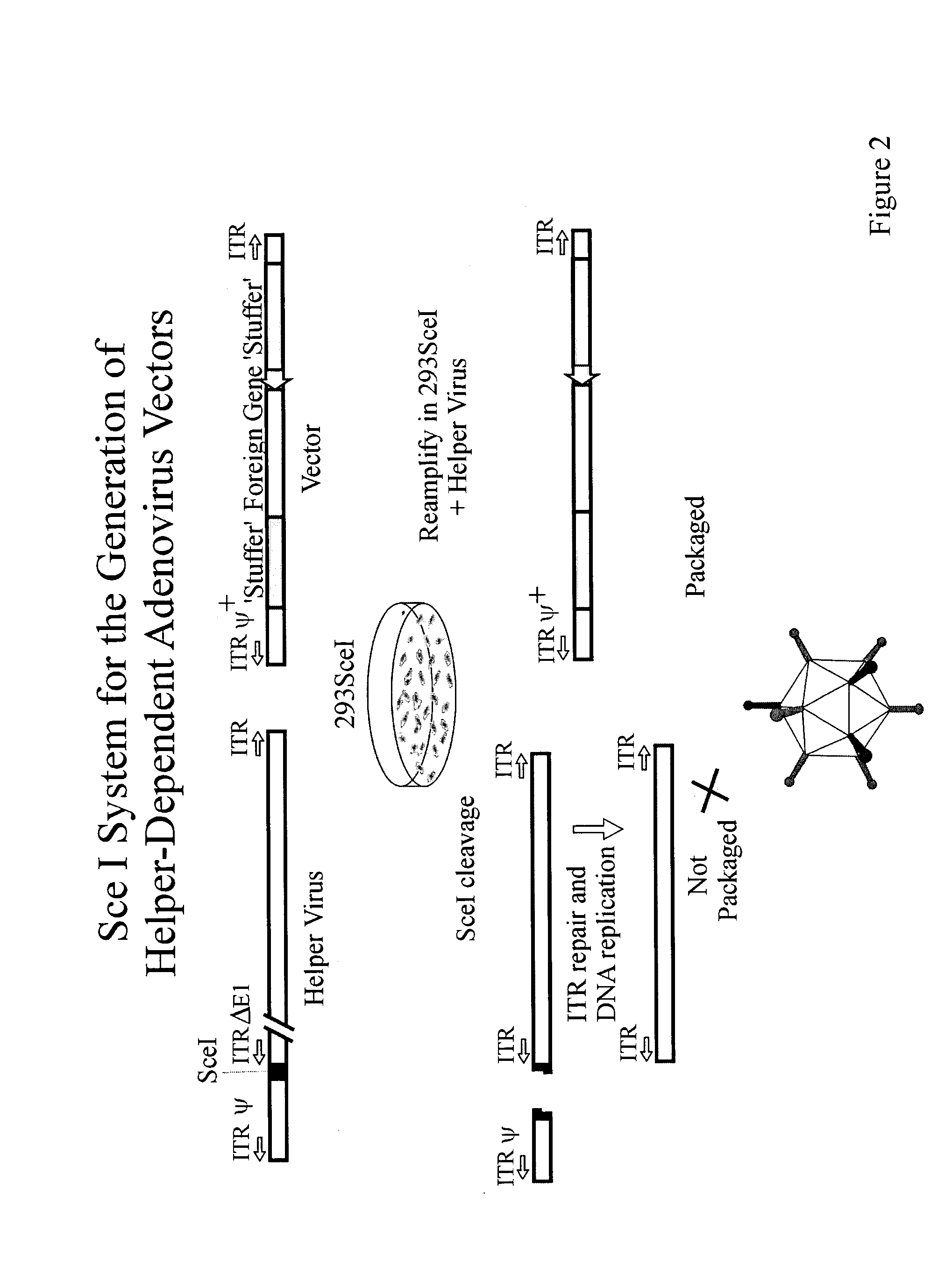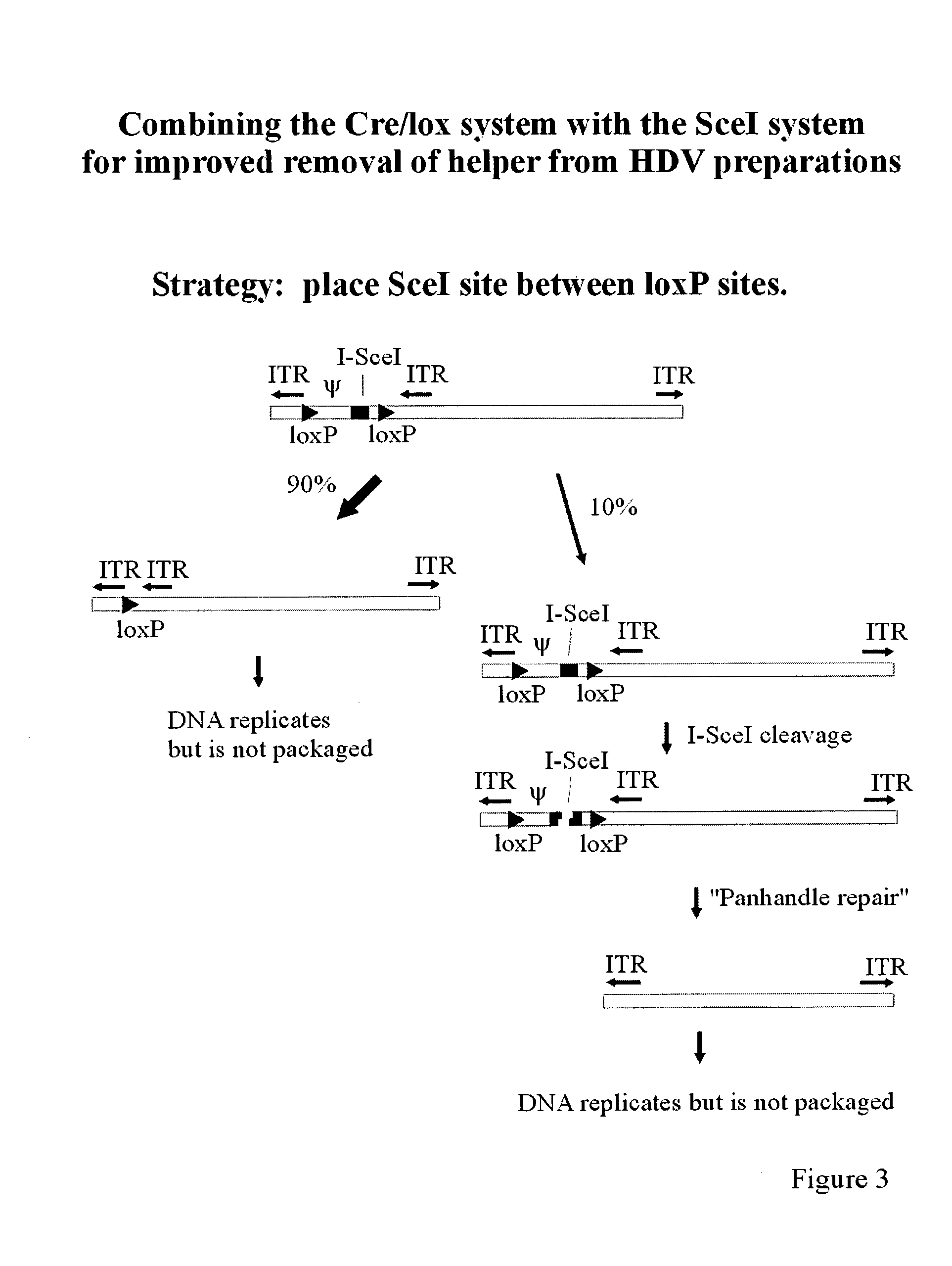System for production of helper dependent adenovirus vectors based on use of endonucleases
a technology of endonuclease and adenovirus, which is applied in the field of producing helper adenoviruses and helperdependent adenovirus vectors, can solve the problems of contamination of helper virus preparations of helper-dependent adenovirus vectors, and achieve the effect of efficient and reliable construction
- Summary
- Abstract
- Description
- Claims
- Application Information
AI Technical Summary
Benefits of technology
Problems solved by technology
Method used
Image
Examples
example 1
Endonuclease Cleavage of Helper Virus
[0076]FIG. 1 shows an adenovirus containing an SceI site near the left end of the viral genome and positioned to the right of the packaging signal, ψ, illustrating the effects of SceI cleavage and ITR repair. Infection of 293SceI cells results in a double strand break in the DNA as a result of SceI endonuclease activity. Because the adjacent, embedded ITR is repaired by panhandle formation (annealing with the right ITR) a functional DNA molecule is formed that is capable of replicating but which lacks the packaging signal and consequently cannot be packaged into virions.
example 2
Propagation of Helper Dependent Adenovirus Vector and Elimination of Helper Virus Contamination Via Endonuclease Cleavage
[0077]FIG. 2 illustrates propagation of a helper dependent Ad vector from which all or most of the viral genes have been deleted and substituted with foreign DNA and “stuffer” DNA. The stuffer DNA is used to maintain an optimal size of the vector's genome to maximize efficiency of packaging. Coinfection of 293SceI cells with the vector and helper results in SceI mediated cleavage of the helper virus DNA as shown. The internal ITR positioned to the right of the SceI site is repaired, resulting in a DNA molecule that is replicated and amplified. However, due to the lack of a packaging signal, the helper viral DNA cannot be packaged into virions. The replicating but non-packageable helper virus DNA provides all of the trans-acting functions necessary for replication of the vector (which lacks all or most viral genes but retains those viral DNA sequences necessary in ...
example 3
Combined Cre / Lox Endonuclease System for Production of Helper Dependent Adenovirus Vectors
[0078]FIG. 3 illustrates the use of a helper virus which includes the Cre / lox system in combination with an endonuclease, an endonuclease target sequence and an embedded ITR for production of helper free helper dependent vectors. To construct this virus an SceI or like endonuclease recognition site is placed between lox sites flanking the packaging signal and an internal ITR is inserted to the right of the second lox site. In a preferred embodiment, the SceI site is placed to the right of the packaging signal, but to the left of the second loxP site. Alternatively, the endonuclease recognition site is placed to the right of the internal lox site but to the left of the internal ITR, or both the SceI site and the embedded ITR are positioned between the packaging signal and the rightmost loxP site. Infection of 293Cre cells which results in efficient but incomplete excision of the packaging signal...
PUM
| Property | Measurement | Unit |
|---|---|---|
| concentrations | aaaaa | aaaaa |
| concentrations | aaaaa | aaaaa |
| concentrations | aaaaa | aaaaa |
Abstract
Description
Claims
Application Information
 Login to View More
Login to View More - R&D
- Intellectual Property
- Life Sciences
- Materials
- Tech Scout
- Unparalleled Data Quality
- Higher Quality Content
- 60% Fewer Hallucinations
Browse by: Latest US Patents, China's latest patents, Technical Efficacy Thesaurus, Application Domain, Technology Topic, Popular Technical Reports.
© 2025 PatSnap. All rights reserved.Legal|Privacy policy|Modern Slavery Act Transparency Statement|Sitemap|About US| Contact US: help@patsnap.com



